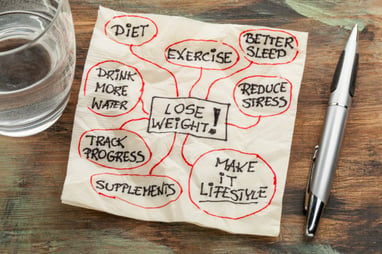 There comes a time when a story of struggle, strife, and success must be shared to remind others that you are never alone in your battle, and that achievement and happiness are closer than you may think. Katie Feltman has such a story.
There comes a time when a story of struggle, strife, and success must be shared to remind others that you are never alone in your battle, and that achievement and happiness are closer than you may think. Katie Feltman has such a story.
I have had the privilege to work with Katie for many years now, and I can remember the first conversation we had out in the fitness center about where she was at the time, where she wanted to go, and how we could work together to get there. I felt her struggle instantly, but I also felt a great deal of determination, evident from the progress she had made before coming to see me. She wasn’t going to take this battle lying down anymore!
I asked Katie to talk about her journey with me so that I could share it with those who may be looking for that spark, that notion that nothing is impossible, but I’Mpossible! Join me in walking in Katie’s shoes as she shares some of her journey with us.
Conversation with Katie, Part I:
Tony: So, take me back about four years and tell me what was going on with you at that time.
Katie: I was living a very different life. A recent doctor’s visit had revealed I weighed 286 pounds, I was pre-diabetic, I had high blood pressure, my LDL cholesterol was high, and I had just found out I had to wear a Holter monitor to diagnose heart arrhythmias I was having. I had lower back pain from herniated discs that required an unhealthy amount of daily Advil to keep at bay (and along with my poor eating habits had created a wicked case of acid reflux that ultimately became an ulcer) and I slept poorly. For 37 years of age, I wasn’t doing okay. I was unhappy.
Tony: What were some of the major struggles you were dealing with?
Katie: Like most people, I had my share of stress sources; nothing extreme or unusual, but I had an ill mother, and a job that looking back now I realized had reached a point that made me miserable. But generally I had nothing going on outside of me that should have triggered the kind of profound lack of self-care I was engaging in on a regular basis.
“I coped with my stress by pushing my feelings inward and washing it all down with sugary processed foods and wine. I made no time to take care of myself.”
 You’d think with the scary words the doctor was saying I would have walked out of there that day and taken charge of things right then. But change isn’t like that—not for me, at least. I was frustrated with how I felt, and I know this will sound superficial but it is true: I hated how I looked, which I didn’t realize then but now know was key to my struggle. Self-hate = no self care, and that was how I was living my life. I was living life in a muted capacity, and I lacked the motivation to do something about it—any of it.
You’d think with the scary words the doctor was saying I would have walked out of there that day and taken charge of things right then. But change isn’t like that—not for me, at least. I was frustrated with how I felt, and I know this will sound superficial but it is true: I hated how I looked, which I didn’t realize then but now know was key to my struggle. Self-hate = no self care, and that was how I was living my life. I was living life in a muted capacity, and I lacked the motivation to do something about it—any of it.
Tony: Can you describe some of what you were feeling at that time?
Katie: I was demoralized and frustrated at what seemed like an impossible and insurmountable task—it was so daunting. Getting healthy, changing how I lived, and peeling pounds off. I wanted instant results from modest change. I’m an extrovert, and my social life at the time revolved heavily around eating out, going to bars, and generally going places where food and booze were the main reasons for being there multiple times per week. But there was a nagging voice in there that knew there was more out there for me—I just wanted to feel better, feel happy most of the time, cope better with the smaller, mundane stresses as well as major things, and sleep better.
Tony: How did these struggles and frustrations affect your life? What did you feel like before you decided to take your life back?
Katie: I felt unhappy, ashamed, and not in control of my own life, and generally was in a terrible place emotionally and physically. And if it hasn’t been stated clearly enough before, I felt like crap pretty much all the time and it wasn’t just physical—it was mental, too. I was in a fog much of the time. I didn’t handle even small stresses well, much less bigger things. I was just floating along with life rather than living the life I really wanted to live.
“I was just floating along with life rather than living the life I really wanted to live.”
READ PART 2 of this amazing story and learn what it took for Katie to make the critical changes that resulted in her being able to take her life back and overcome obesity and a lack of healthy habits and see measurable weight loss.*
This blog was written by Tony Maloney, ACSM Certified Exercise Physiologist and Fitness Center Manager. To find out more about the NIFS bloggers, click here.
***
Getting started is the hardest part...Let us help! Sign up for a free Fitness Assessment today!


 If you have read the news lately, I’m sure you have seen that the world’s obesity epidemic is most recently being blamed on sugar. This is with good reason, too. In 1922 the average American ate the amount of sugar found in one 12-ounce soda every five days. Now, that amount is consumed every seven hours. Sugar is in everything—not just baked goods and
If you have read the news lately, I’m sure you have seen that the world’s obesity epidemic is most recently being blamed on sugar. This is with good reason, too. In 1922 the average American ate the amount of sugar found in one 12-ounce soda every five days. Now, that amount is consumed every seven hours. Sugar is in everything—not just baked goods and 
 It can be hard trying to change your lifestyle or fitness on your own. It can be even harder if you don’t have support from your family and friends. You family and friends can play a key role in your fitness journey, so why not get them involved and gain their support? Including them in your journey can help your motivation and help you enjoy the path to your fitness and health goals.
It can be hard trying to change your lifestyle or fitness on your own. It can be even harder if you don’t have support from your family and friends. You family and friends can play a key role in your fitness journey, so why not get them involved and gain their support? Including them in your journey can help your motivation and help you enjoy the path to your fitness and health goals. 

 One of my main rules of thumb when helping clients with their food and nutrition choices is to choose more real foods. So why is it that when you are training or working out for over an hour, you hear about the importance of sugary and packaged drinks, gels, and bars?
One of my main rules of thumb when helping clients with their food and nutrition choices is to choose more real foods. So why is it that when you are training or working out for over an hour, you hear about the importance of sugary and packaged drinks, gels, and bars?  Weight loss tends to be one of the most controversial topics talked about, but I want to take a positive approach. With the new year right here, weight loss tops the list of many people’s New Year’s resolutions.
Weight loss tends to be one of the most controversial topics talked about, but I want to take a positive approach. With the new year right here, weight loss tops the list of many people’s New Year’s resolutions. 

 One of my favorite things to do once it is summer in Indiana is to visit the various farmers’ markets around town. As a dietitian I am a sucker for the
One of my favorite things to do once it is summer in Indiana is to visit the various farmers’ markets around town. As a dietitian I am a sucker for the 
 Are you excited about your progress thus far in 2020 toward those goals you set back in January?
Are you excited about your progress thus far in 2020 toward those goals you set back in January?  Even though it’s been a few years since I graduated, it still feels like I was just walking through campus and living in the dorm. I absolutely loved college, and while many people gained the
Even though it’s been a few years since I graduated, it still feels like I was just walking through campus and living in the dorm. I absolutely loved college, and while many people gained the  As a natural-born morning person, many people frequently ask what my secret is for bursts of energy before the sun rises. While I may naturally be a morning person, there are a few things that I do in order to guarantee a successful morning workout because, believe it or not, there are times that even I find it hard to drag my bod to the gym to start my day.
As a natural-born morning person, many people frequently ask what my secret is for bursts of energy before the sun rises. While I may naturally be a morning person, there are a few things that I do in order to guarantee a successful morning workout because, believe it or not, there are times that even I find it hard to drag my bod to the gym to start my day.